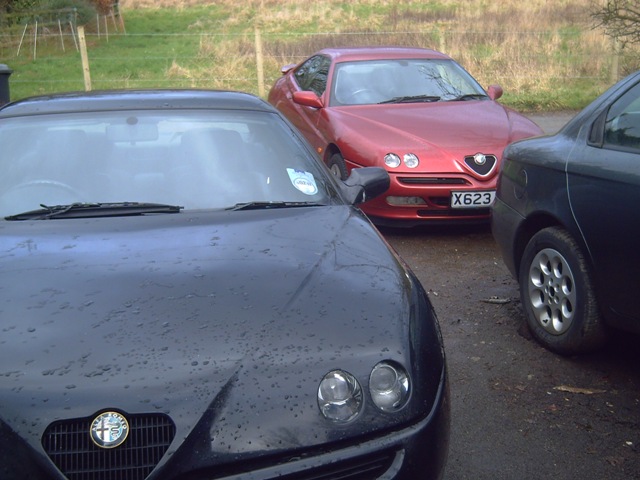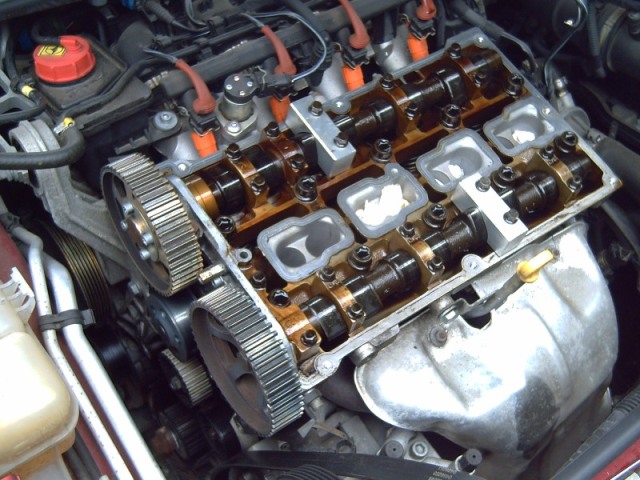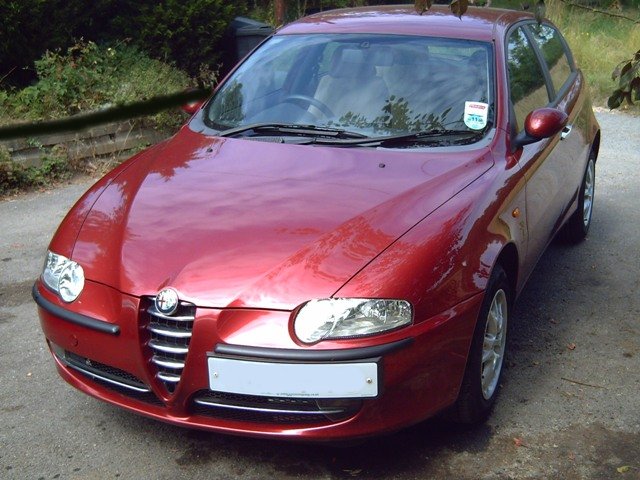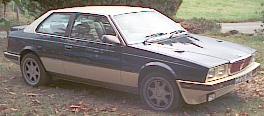FAQs
Alfa Romeo FAQs
- Keep the oil topped up. If it falls below the "minimum" mark on the
dipstick, you're in trouble. If the "low pressure" light on the dashboard
lights up, you've already wrecked the engine. Some vehicles have an oil level sensor,
but it often doesn't work that well so be sure to check it manually as well.
- Change the oil. Use Selenia semi-synthetic oil, and change it every 12,000
miles. Or sooner if you want your engine to last forever. It's a lot of hassle
 to
change the oil - the undertray has to be removed, and on a V6 you have to
move part of the power steering or aircon system out of the way to get at the oil filter, so
many previous owners don't bother, or change it very infrequently. This will
destroy an Alfa engine. Some might recommend a fully synthetic oil, but this
tends to drain away far too quickly leaving the top end of the engine starved
of lubricant at start up. This is especially true of twin-spark cars fitted
with cam variators. Semi synthetic oil has much better cling characteristics
and will preserve your engine. That's why Alfa Romeo specify semi-synthetic,
the engine was designed for it, and it was originally filled with it. Fully
synthetic is the wrong oil for your car. Also, look at the specification of
the oil - you'll need at least an API SJ spec oil. The 156 was designed for API SJ oil - look at the recommended
lubricant sticker in your engine bay.
to
change the oil - the undertray has to be removed, and on a V6 you have to
move part of the power steering or aircon system out of the way to get at the oil filter, so
many previous owners don't bother, or change it very infrequently. This will
destroy an Alfa engine. Some might recommend a fully synthetic oil, but this
tends to drain away far too quickly leaving the top end of the engine starved
of lubricant at start up. This is especially true of twin-spark cars fitted
with cam variators. Semi synthetic oil has much better cling characteristics
and will preserve your engine. That's why Alfa Romeo specify semi-synthetic,
the engine was designed for it, and it was originally filled with it. Fully
synthetic is the wrong oil for your car. Also, look at the specification of
the oil - you'll need at least an API SJ spec oil. The 156 was designed for API SJ oil - look at the recommended
lubricant sticker in your engine bay.
-
Change the cam belt every three years. Cam belts deteriorate with time,
as well as mileage, so make sure you change them regularly. You really don't
want to see what happens when they snap. You need a lot of special tools to
change the cam belt, so if you're
 thinking of trying to do it yourself, good
luck. Alfa seemed to say that you only needed to replace the cam belt every
72K, so why do we say 36K? Well, if you look in the small print the official
Alfa service schedule calls for the belt to be "inspected" after 36K.
However, when they say "inspected" they mean the belt has the be removed,
examined with a magnifying glass, a new belt fitted if there's any doubt,
and then the cam timing and the belt tensioner need resetting. So, it's no
harder, and no more expensive, to replace the belt every 36K. A few years
ago, Alfa officially changed the
thinking of trying to do it yourself, good
luck. Alfa seemed to say that you only needed to replace the cam belt every
72K, so why do we say 36K? Well, if you look in the small print the official
Alfa service schedule calls for the belt to be "inspected" after 36K.
However, when they say "inspected" they mean the belt has the be removed,
examined with a magnifying glass, a new belt fitted if there's any doubt,
and then the cam timing and the belt tensioner need resetting. So, it's no
harder, and no more expensive, to replace the belt every 36K. A few years
ago, Alfa officially changed the recommended interval to 36K or 3 years and your dealer should have stuck a
new page in your manual saying so. If he hasn't, then shame on him! Click on
the pic to see what it should say...
recommended interval to 36K or 3 years and your dealer should have stuck a
new page in your manual saying so. If he hasn't, then shame on him! Click on
the pic to see what it should say...
- Change the latest spec pulleys every 72,000 miles. These deteriorate with mileage,
not time. Virtually all (pre-'05) TS cam belt pulleys were replaced by Alfa at about
36,000 miles with stronger ones that they reckon will last 72,000 miles. If your cam
belt tensioner pulley is black and not the new stronger white one, then stop
your car and trailer it to us. It's going to wreck your engine any second
now and it's a miracle that it's still in one piece! Even these later white
ones have now been replaced with all steel. We always replace the tensioner
and idler when we change the cambelt.
- Change the air filter. It's very awkward to change and most owners don't
bother. On a 156 the bolts that hold it together seize up and as they are anchored in
plastic will just strip. We have to cut through a lot of those bolts...
- Keep an eye on your brakes, they wear out very quickly. Once the
hardened outer 1mm thickness of disc has been worn through, the discs will
wear very quickly leading to scoring,
 lipping, and warping. If you can feel
a pronounced "lip" at the edge of the disc, then you're looking at needing
new ones very soon. Due to the nature of the calipers, the inside of the
discs - the bit you can't easily see - is always far worse than the outside
that you can see. Rather unfortunately, if the pad wear indicator wire
wears through, breaks, or just becomes disconnected, then the warning light
will not come on - it's a "fail off" system. So, your pads can wear down to
nothing, and it still won't tell you.
lipping, and warping. If you can feel
a pronounced "lip" at the edge of the disc, then you're looking at needing
new ones very soon. Due to the nature of the calipers, the inside of the
discs - the bit you can't easily see - is always far worse than the outside
that you can see. Rather unfortunately, if the pad wear indicator wire
wears through, breaks, or just becomes disconnected, then the warning light
will not come on - it's a "fail off" system. So, your pads can wear down to
nothing, and it still won't tell you.
- If your car has done 50K to 70K and the performance and fuel economy
isn't what it was, then your Lambda sensor is probably wearing out or even
failed completely. There's a lot of internet blah-blah about the MAF or the
variator, but it's usually the Lambda. They are not designed to last more than 60K. On BMWs
replacing the Lambda sensor is a service item at the 60K service, and is the
same part. So why not on an Alfa? Who knows. Change it (or them on later
cars) at 60K and you'll be surprised at the difference. We actually have an
official Alfa Romeo dealer lambda sensor testing kit, which rather helpfully
tells you what in your sensor has failed, but there's not a lot you can do
about it other than replace the sensor.
- If your temperature gauge sits on "90" when in traffic or idling, then
plummets when you drive at any speed then your thermostat has failed. Modern
thermostats fail open, so the coolant will be circulating through the
radiator at all times, rather than just when it gets to a certain
temperature. Incidentally, the "90" on the gauge isn't really degrees
centigrade. It's just a number people are happy seeing a temperature needle
at. The engine tends to run at its best at between 94C and 104C and usually
sits on 98C, but many people believe that water boils at 100C and that
worries them. In this application it won't boil until around 125C.
Maserati FAQs
- Change the oil. Use the correct fully synthetic oil, and change it frequently - more
frequently than the rather optimistic service schedule if possible. The conditions inside a Maserati engine shred the oil pretty quickly.
A non-synthetic oil will clog everything up and trash your engine. To change
the oil filter you may have to remove the radiator on early V6 cars (for the
full size filter, although there is a Maserati low profile filter that
doesn't need the radiator removing, but supply from Maserati is sporadic), and the turbo
ducting
on later cars, so make sure this has been done properly with a genuine Maserati oil
filter. The correct oil for the turbo cars is Selenia Racing,
and for the non-turbo V8s it's Shell Helix Ultra. We only use the correct
oils.
- The later V8 cars have a 6,000 mile recommended service interval. On the V6s, they have a
6,000 mile service interval, but recommend changing the oil at 5,000 Km
(about 3K Miles). I would suggest that this be applied to all engines with
plain bearing turbos, so, early V8 QPs as well.
-
 Maserati
say to change the cam belt every three years
or 18K Miles. Cam belts deteriorate with time,
as well as mileage, so make sure you change them regularly.
Maserati
say to change the cam belt every three years
or 18K Miles. Cam belts deteriorate with time,
as well as mileage, so make sure you change them regularly.
- On carburettor cars, the fuel pipe from the plenum chamber wall to the
carburettor has to go through a very tight angle, this leads to cracking and leaks, which leads
to your car blowing up. Check it and replace it regularly.
- Dealer servicing of Maseratis is very expensive. I'm often asked why
we're a lot cheaper. Perhaps you should ask the dealers why they're so much
more expensive instead? We use original Maserati parts, and the correct
Selenia and Tutela oils and fluids on the 3200GT and Shell Helix Ultra on the 4200GT. We do not cut corners.
- Radiators can leak. Not because the radiator is poor - on the contrary,
it's extremely robust, but because the lower water pipe into the side tank
can crack its joint. The rubber hose that attaches here needs to be removed
when you change the cam belt and if the person doing the work is a bit
rushed, then wiggling the hose to get it off will put a lot of strain on
this joint and it will crack and leak. Having seen a lot of these -
especially when a car has just had its cambelt changed at a dealership as
they sometimes rush it. The other problem is that there are some interal
rubber hoses between the two cores, which rot, and have plain steel screw
clamps, which rust. We use stainless steel screw clamps. We can supply a fully recored radiator for £399
plus fitting.
- Starter motors have started to become a bit of a problem. As they're not
really up to the job, they can suffer from a number of maladies, especially
as they sit in the "V" of the V8 which can often fill with water from minor
water leaks in the coolant distribution pipes that run under the inlet
manifold. All this puts a bit of a strain on a motor originally designed to
start a French shopping car (Maserati just changed the gear teeth pitch on
the internal gearing). With a new motor from Maserati approaching £400 and
the original manufacturer claiming not to make them any more, we can rebuild
your old motor for £149. Fitting a
starter motor is a more than challenging task, and should you not wish to go
through all the hassle of removing the inlet manifold, fuel injection
system, and much of the cooling system, we'll be more than happy to do it
for you.
- V8 Service intervals. There is much chatter on the web about service
intervals as the factory documentation dictates 6K Mile (10K Km) service
intervals, yet the owners handbook seems to suggest 12K Miles (20K Km)
intervals. The explanation is that the service regime in the handbook
actually mandates a 12K Mile (20 K Km) service AND a 12 month service as
well. So, if you were driving 12K Miles a year in a brand new Maserati
3200GT, the first service would be at 6K Miles and about 6 months, then
after a year, and about 12K Miles, you would have a second service - thus
having two services in a year and two in 12K Miles. The next service would
be at 18K Miles, and about 18 months, the next at 24 Months and about 24K
Miles. However, most people don't drive their Maserati like a rep's Mondeo
and rarely manage 1,000 miles a month. So, a 6K Mile service schedule is
good enough. The only service items that are "lifed" on age as well as
mileage are the brake fluid (which absorbs water over time) and the cambelt
which goes brittle with time. So, change your brake fluid every two years
and your cambelt every three years, regardless of how many miles you've
done... Some Maserati dealers will change various parts on age, rather than
miles, when this is not necessary - such as Lambda sensors. These need
changing after 60K miles, but are not time limited.
Home
 to
change the oil - the undertray has to be removed, and on a V6 you have to
move part of the power steering or aircon system out of the way to get at the oil filter, so
many previous owners don't bother, or change it very infrequently. This will
destroy an Alfa engine. Some might recommend a fully synthetic oil, but this
tends to drain away far too quickly leaving the top end of the engine starved
of lubricant at start up. This is especially true of twin-spark cars fitted
with cam variators. Semi synthetic oil has much better cling characteristics
and will preserve your engine. That's why Alfa Romeo specify semi-synthetic,
the engine was designed for it, and it was originally filled with it. Fully
synthetic is the wrong oil for your car. Also, look at the specification of
the oil - you'll need at least an API SJ spec oil. The 156 was designed for API SJ oil - look at the recommended
lubricant sticker in your engine bay.
to
change the oil - the undertray has to be removed, and on a V6 you have to
move part of the power steering or aircon system out of the way to get at the oil filter, so
many previous owners don't bother, or change it very infrequently. This will
destroy an Alfa engine. Some might recommend a fully synthetic oil, but this
tends to drain away far too quickly leaving the top end of the engine starved
of lubricant at start up. This is especially true of twin-spark cars fitted
with cam variators. Semi synthetic oil has much better cling characteristics
and will preserve your engine. That's why Alfa Romeo specify semi-synthetic,
the engine was designed for it, and it was originally filled with it. Fully
synthetic is the wrong oil for your car. Also, look at the specification of
the oil - you'll need at least an API SJ spec oil. The 156 was designed for API SJ oil - look at the recommended
lubricant sticker in your engine bay. thinking of trying to do it yourself, good
luck. Alfa seemed to say that you only needed to replace the cam belt every
72K, so why do we say 36K? Well, if you look in the small print the official
Alfa service schedule calls for the belt to be "inspected" after 36K.
However, when they say "inspected" they mean the belt has the be removed,
examined with a magnifying glass, a new belt fitted if there's any doubt,
and then the cam timing and the belt tensioner need resetting. So, it's no
harder, and no more expensive, to replace the belt every 36K. A few years
ago, Alfa officially changed the
thinking of trying to do it yourself, good
luck. Alfa seemed to say that you only needed to replace the cam belt every
72K, so why do we say 36K? Well, if you look in the small print the official
Alfa service schedule calls for the belt to be "inspected" after 36K.
However, when they say "inspected" they mean the belt has the be removed,
examined with a magnifying glass, a new belt fitted if there's any doubt,
and then the cam timing and the belt tensioner need resetting. So, it's no
harder, and no more expensive, to replace the belt every 36K. A few years
ago, Alfa officially changed the recommended interval to 36K or 3 years and your dealer should have stuck a
new page in your manual saying so. If he hasn't, then shame on him! Click on
the pic to see what it should say...
recommended interval to 36K or 3 years and your dealer should have stuck a
new page in your manual saying so. If he hasn't, then shame on him! Click on
the pic to see what it should say... lipping, and warping. If you can feel
a pronounced "lip" at the edge of the disc, then you're looking at needing
new ones very soon. Due to the nature of the calipers, the inside of the
discs - the bit you can't easily see - is always far worse than the outside
that you can see. Rather unfortunately, if the pad wear indicator wire
wears through, breaks, or just becomes disconnected, then the warning light
will not come on - it's a "fail off" system. So, your pads can wear down to
nothing, and it still won't tell you.
lipping, and warping. If you can feel
a pronounced "lip" at the edge of the disc, then you're looking at needing
new ones very soon. Due to the nature of the calipers, the inside of the
discs - the bit you can't easily see - is always far worse than the outside
that you can see. Rather unfortunately, if the pad wear indicator wire
wears through, breaks, or just becomes disconnected, then the warning light
will not come on - it's a "fail off" system. So, your pads can wear down to
nothing, and it still won't tell you. Maserati
say to change the cam belt every three years
or 18K Miles. Cam belts deteriorate with time,
as well as mileage, so make sure you change them regularly.
Maserati
say to change the cam belt every three years
or 18K Miles. Cam belts deteriorate with time,
as well as mileage, so make sure you change them regularly.